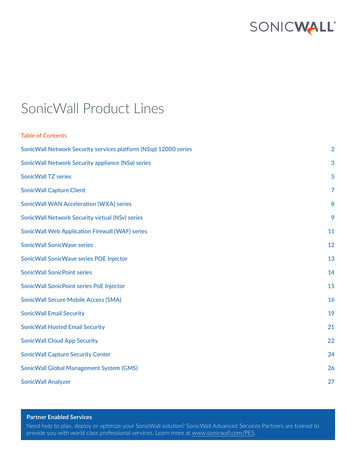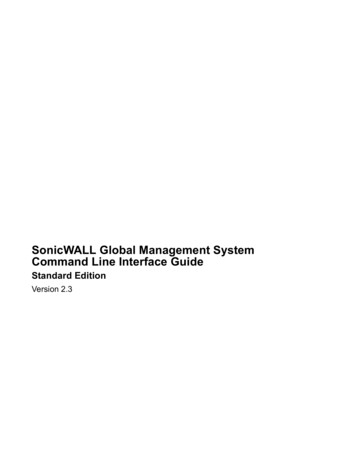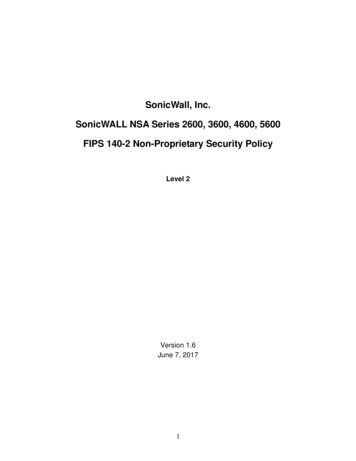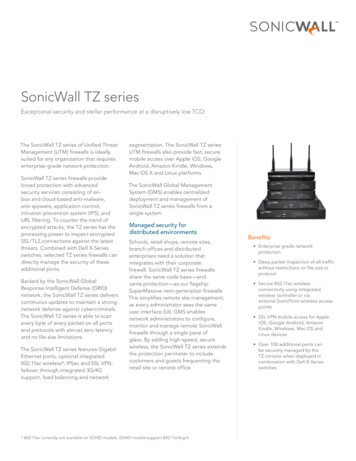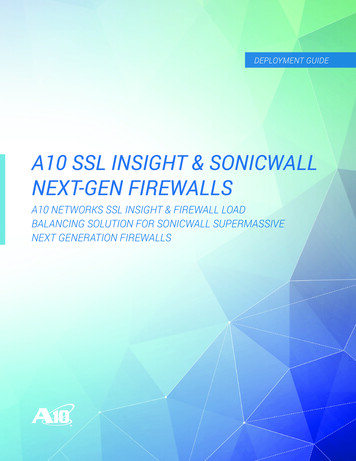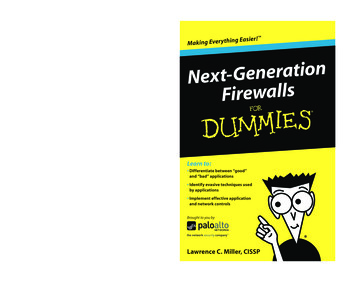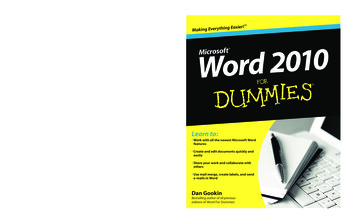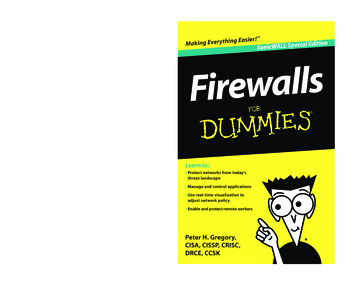
Transcription
g Easier!Making EverythinControl, manage, and protect yournetwork easily and automatically!It can be a real challenge for IT administrators tomaximize the business value of web applicationswhile minimizing the risk. Today’s firewalls makethe job easy with granular control and real-timevisualization of applications to guarantee bandwidthprioritization and ensure maximum network securityand productivity. This turns the traditional gatewayfirewall into something much more important: aproductivity optimization tool. Shut threats out at the gateway — detectand eliminate malware, intrusions, dataleakage, and policy violations Seize control of your applications —prioritize bandwidth to mission-criticalapplications and restrict bandwidth fornon-productive applicationsl EditionSonicWALL SpeciaOpen the book and find:sllawFire How today’s threatlandscape has changed How firewall technologyhas advanced How to prioritize criticalapplications whileminimizing risk How to protect anyuser, anywhere How advanced firewallsimprove employeeproductivity Take command of your network —manageconfigurations, view real-time monitoringmetrics, and integrate policy and compliancereporting Secure and enable your remote workforce —extend easy-to-manage intrusion preventionand anti-malware to mobile employees andbranch offices Learn to: Protect networks from today’sthreat landscape Manage and control applicationsGo to Dummies.com for videos, step-by-step examples,how-to articles, or to shop! Use real-time visualization toadjust network policy Enable and protect remote workersISBN: 978-1-118-06194-7Not for resalePeter H. Gregory,CISA, CISSP, CRISC,DRCE, CCSK
About SonicWALLSonicWALL , Inc. provides intelligent network security and data protectionsolutions that enable customers and partners — around the world — todynamically secure, control, and scale their global networks. Built on a sharednetwork of millions of global touch points, SonicWALL Dynamic Securitybegins by leveraging the SonicWALL Global Response Intelligent Defense(GRID) Network and the SonicWALL Threat Center that provide continuouscommunication, feedback, and analysis regarding the nature and changingbehavior of threats worldwide.Leveraging its patented* Reassembly-Free Deep Packet Inspection technology in combination with a high speed, multi-core parallel hardwarearchitecture, SonicWALL enables simultaneous, multi-threat scanning andanalysis at wire speed and provides the technical framework that allows theentire solution to scale for deployment in high bandwidth networks.The SonicWALL family of firewalls tightly integrates intrusion prevention,malware protection, and application intelligence and control with real-timevisualization. Solutions are available for the SMB through the Enterprise andare deployed in large campus environments, distributed enterprise settings,government, retail point-of-sale and healthcare segments, as well asthrough service providers.For more information visit www.sonicwall.com.*U.S. Patents 7,310,815; 7,600,257; 7,738,380; 7,835,361; 7,991,723These materials are the copyright of John Wiley & Sons, Inc. and anydissemination, distribution, or unauthorized use is strictly prohibited.
FirewallsFORDUMmIES‰SONICWALL SPECIAL EDITIONby Peter H. Gregory,CISA, CISSP, CRISC,DRCE, CCSKThese materials are the copyright of John Wiley & Sons, Inc. and anydissemination, distribution, or unauthorized use is strictly prohibited.
Firewalls For Dummies , SonicWALL Special EditionPublished byJohn Wiley & Sons, Inc.111 River StreetHoboken, NJ 07030-5774www.wiley.comCopyright 2011 by John Wiley & Sons, Inc.Published by John Wiley & Sons, Inc., Hoboken, New JerseyNo part of this publication may be reproduced, stored in a retrieval system or transmitted in anyform or by any means, electronic, mechanical, photocopying, recording, scanning or otherwise,except as permitted under Sections 107 or 108 of the 1976 United States Copyright Act, without theprior written permission of the Publisher. Requests to the Publisher for permission should beaddressed to the Permissions Department, John Wiley & Sons, Inc., 111 River Street, Hoboken, NJ07030, (201) 748-6011, fax (201) 748-6008, or online at http://www.wiley.com/go/permissions.Trademarks: Wiley, the Wiley logo, For Dummies, the Dummies Man logo, A Reference for the Restof Us!, The Dummies Way, Dummies.com, Making Everything Easier, and related trade dress aretrademarks or registered trademarks of John Wiley & Sons, Inc. and/or its affiliates in the UnitedStates and other countries, and may not be used without written permission. All other trademarksare the property of their respective owners. John Wiley & Sons, Inc., is not associated with anyproduct or vendor mentioned in this book.LIMIT OF LIABILITY/DISCLAIMER OF WARRANTY: THE PUBLISHER AND THE AUTHOR MAKENO REPRESENTATIONS OR WARRANTIES WITH RESPECT TO THE ACCURACY ORCOMPLETENESS OF THE CONTENTS OF THIS WORK AND SPECIFICALLY DISCLAIM ALLWARRANTIES, INCLUDING WITHOUT LIMITATION WARRANTIES OF FITNESS FOR APARTICULAR PURPOSE. NO WARRANTY MAY BE CREATED OR EXTENDED BY SALES ORPROMOTIONAL MATERIALS. THE ADVICE AND STRATEGIES CONTAINED HEREIN MAY NOT BESUITABLE FOR EVERY SITUATION. THIS WORK IS SOLD WITH THE UNDERSTANDING THATTHE PUBLISHER IS NOT ENGAGED IN RENDERING LEGAL, ACCOUNTING, OR OTHERPROFESSIONAL SERVICES. IF PROFESSIONAL ASSISTANCE IS REQUIRED, THE SERVICES OF ACOMPETENT PROFESSIONAL PERSON SHOULD BE SOUGHT. NEITHER THE PUBLISHER NORTHE AUTHOR SHALL BE LIABLE FOR DAMAGES ARISING HEREFROM. THE FACT THAT ANORGANIZATION OR WEBSITE IS REFERRED TO IN THIS WORK AS A CITATION AND/OR APOTENTIAL SOURCE OF FURTHER INFORMATION DOES NOT MEAN THAT THE AUTHOR ORTHE PUBLISHER ENDORSES THE INFORMATION THE ORGANIZATION OR WEBSITE MAYPROVIDE OR RECOMMENDATIONS IT MAY MAKE. FURTHER, READERS SHOULD BE AWARETHAT INTERNET WEBSITES LISTED IN THIS WORK MAY HAVE CHANGED OR DISAPPEAREDBETWEEN WHEN THIS WORK WAS WRITTEN AND WHEN IT IS READ.For general information on our other products and services, please contact our Business DevelopmentDepartment in the U.S. at 317-572-3205. For details on how to create a custom For Dummies book foryour business or organization, contact info@dummies.biz. For information about licensing theFor Dummies brand for products or services, contact BrandedRights&Licenses@Wiley.com.ISBN: 978-1-118-06194-7Manufactured in the United States of America10 9 8 7 6 5 4 3 2 1These materials are the copyright of John Wiley & Sons, Inc. and anydissemination, distribution, or unauthorized use is strictly prohibited.
Table of ContentsIntroduction. . . . . . . . . . . . . . . . . . . . . . . . . . . . . . . . . . . . . . . . . . . . 1How This Book Is Organized. 1Icons Used in This Book. 2Where to Go from Here. 2Chapter 1: Understanding Threats andthe Role of Firewalls . . . . . . . . . . . . . . . . . . . . . . . . . . . . . . . . . 3Understanding the Threat Landscape. 3Looking at the Types of Firewalls. 7Chapter 2: Examining Features in Today’s Firewalls. . . . . . . 13Access Rules. 13Intrusion Prevention (IPS). 14Reassembly-Free Deep Packet Inspection. 15Antivirus and Antispyware. 16Antispam. 16Controlling Web Content. 17Providing Remote Access: VPN. 18Application Intelligence and Control. 18Logging and Alerting. 19Chapter 3: Uncovering Advanced Firewall Features . . . . . . . 21Deep-Packet Inspection of Encrypted Network Traffic. 21Application Intelligence, Control, and Visualization. 22Data Leakage Prevention. 26Management in Large Distributed Enterprises. 28Network Performance Management and Monitoring. 29Advanced Reporting. 30Chapter 4: Enabling and Protecting Remote Workers . . . . . . 31Understanding Trends in Remote Working. 31Understanding the Risks of Remote Working. 33Enabling Remote Work Without Compromising Security. 35Chapter 5: Ten Advantages of Next-GenerationFirewalls. . . . . . . . . . . . . . . . . . . . . . . . . . . . . . . . . . . . . . . . . . . 39Consolidated Network Architecture. 39Single Configuration for Management of All Threats. 40Single UI for Viewing and Managing Threat Events. 40Improved Security Defense in Depth. 41Improved Control Over Applications. 41Easier to Manage Through Intuitive UIs. 42All the Enterprise’s Network Security in One Place. 43A Single View of Enterprise Network Security. 43Secure Wireless and Remote Access. 44Helps Keep You Out of the News. 44These materials are the copyright of John Wiley & Sons, Inc. and anydissemination, distribution, or unauthorized use is strictly prohibited.
Publisher’s AcknowledgmentsWe’re proud of this book and of the people who worked on it. For details on how tocreate a custom For Dummies book for your business or organization, contact info@dummies.biz. For details on licensing the For Dummies brand for products or services,contact BrandedRights&Licenses@Wiley.com.Some of the people who helped bring this book to market include the following:Acquisitions, Editorial, and MediaDevelopmentProject Editor: Carrie A. BurchfieldEditorial Manager: Rev MengleBusiness Development Representative:Kimberley SchumackerCustom Publishing Project Specialist:Michael SullivanCartoons: Rich Tennant(www.the5thwave.com)Composition ServicesSr. Project Coordinator: Kristie ReesLayout and Graphics: Lavonne RobertsProofreader: Melanie HoffmanSpecial Help from SonicWALL:Dori Legard, John Gordineer,Eric Crutchlow, Scott Grebe,Heather O’ReillyPublishing and Editorial for Technology DummiesRichard Swadley, Vice President and Executive Group PublisherAndy Cummings, Vice President and PublisherMary Bednarek, Executive Director, AcquisitionsMary C. Corder, Editorial DirectorPublishing and Editorial for Consumer DummiesKathleen Nebenhaus, Vice President and Executive PublisherComposition ServicesDebbie Stailey, Director of Composition ServicesBusiness DevelopmentLisa Coleman, Director, New Market and Brand DevelopmentThese materials are the copyright of John Wiley & Sons, Inc. and anydissemination, distribution, or unauthorized use is strictly prohibited.
IntroductionWith this book, you get “must have” information aboutnext-generation firewalls to understand how theywork and the threats they counter. If your organization hasnetworks connected to the Internet, you need the informationin this book if you want to protect your network from threatsthat continue to grow in their power and impact.How This Book Is OrganizedThe main purpose of this book is to acquaint you with nextgeneration firewalls and how they protect your organization.In Chapter 1, Understanding Threats and the Role ofFirewalls, I explain today’s threat landscape and how firewallshelp to protect an organization against these threats.Chapter 2, Examining Features in Today’s Firewalls, is areview of the common features found in firewall productsavailable today. Each feature is described in detail.Then, in Chapter 3, Uncovering Advanced Firewall Features,I discuss more firewall features, primarily those found inadvanced firewall products.Next, Chapter 4, Enabling and Protecting Remote Workers,explains remote access and remote management technologiespresent in firewalls that protect remote workers, their communications with internal networks, and the internal networksthemselves.Finally in Chapter 5: Ten Advantages of Next-GenerationFirewalls, I list ten things about next-generation firewalls thatmake you wonder how you ever got along without them.These materials are the copyright of John Wiley & Sons, Inc. and anydissemination, distribution, or unauthorized use is strictly prohibited.
2Firewalls For Dummies, SonicWALL Special EditionIcons Used in This BookIcons are used throughout this book to call attention to material worth noting in a special way. Here is a list of the iconsalong with a description of what each means:Some points bear repeating, and others bear remembering.When you see this icon, take special note of what you’reabout to read.This icon indicates technical information that is probablymost interesting to technology planners and architects.If you see a Tip icon, pay attention — you’re about to find outhow to save some aggravation and time.Where to Go from HereWhether you’ve been managing firewalls for years or if firewallsare a new subject, there’s something in this book for you. Ifyou’re just starting out with firewalls, I suggest you begin withChapter 1 to understand today’s network-borne threats andhow firewalls protect networks from those threats.If you’re experienced with firewalls and you want to understandthe newer features found in firewalls, jump to Chapters 2 and 3.If you’re interested in telework and other remote access topics,Chapter 4 is where you want to go.If you need a quick understanding of the advantages of nextgeneration firewalls, turn to Chapter 5 where you find the ForDummies tried and true ten reasons why next-generation firewalls are needed to protect organizations’ networks.These materials are the copyright of John Wiley & Sons, Inc. and anydissemination, distribution, or unauthorized use is strictly prohibited.
Chapter 1Understanding Threats andthe Role of FirewallsIn This Chapter Learning about traditional and evolving threats Taking a look at modern firewallsThreats: Not just hypothetical ideas, but real: malware, botnets, hackers, spam, and organized crime. They want totake control of your computers, steal your data, and use yoursystems to attack their next victim. A generation ago, firewallswere enough to protect against this. Today, alone, they hardlymake a difference. Instead, a plethora of defenses are neededto repel the variety of attacks that are bombarding every corporate network.Understanding theThreat LandscapeThe Internet is the global marketplace of businesses, schools,and governments, the prime medium for personal and business communication, and the meeting place for personal andbusiness networking. Practically everything that happens inthe world happens on the Internet, or the Internet is used tocommunicate these events to others.The Internet is also the medium of choice for organized crimethroughout the world. Not only is the Internet the means fortheir communication, but also businesses, governments, andschools on the Internet are targets of organized crime for thepurposes of next-generation profiteering through a variety ofThese materials are the copyright of John Wiley & Sons, Inc. and anydissemination, distribution, or unauthorized use is strictly prohibited.
4Firewalls For Dummies, SonicWALL Special Editionillegal activities, such as theft and fraud. For example, criminal organizations build botnets to take control of thousands ofusers’ computers and use them to send spam, launch phishing schemes, and attack more systems.Technology companies are driving innovation through thedevelopment of new web technologies like Web 2.0. But hackersare innovating too, with ever-improving tools and techniquesfor discovering and exploiting technical and human vulnerabilities to deface, defraud, and steal. The phrase “cat and mouse”comes to mind just now, but this phrase is too playful and childlike. Nation-states are getting into the game, too, by carrying outattacks to conduct espionage and to disrupt government andmilitary networks (you can call this cyberwar).Older but still potent threatsThe original targets of hackers were computer operating systems. Designed in an era of mutual trust, the computer operating systems of the 80s and early 90s assumed that anyone onthe network was vetted and trusted. But as organizations connected themselves to the Internet, unknown actors could nowcommunicate, and some of them were there to bring harm toanyone vulnerable to it.Early threat paradigmsEarlier generations of threats took the form of tools and techniques used to identify features in a computer’s operatingsystem that were Active: This refers to whether a potentially-vulnerablefeature in an operating system is running. Accessible: This refers to whether a remote attacker isable to remotely access a potentially-vulnerable operating system’s features. Vulnerable: If the operating system feature has somekind of a weakness, an attacker may be able to takeadvantage of this. Exploitable: By this I mean that any vulnerability in anoperating system can be used by an attacker to causethe feature or the entire system to malfunction, or maygive the attacker partial or complete control of theoperating system.These materials are the copyright of John Wiley & Sons, Inc. and anydissemination, distribution, or unauthorized use is strictly prohibited.
Chapter 1: Understanding Threats and the Role of Firewalls5While you may find many sexier and more valuable exploitstoday, the tools that intruders use to discover and exploitvulnerabilities still include all the basic operating system-levelweaknesses. This is like saying an intruder who may try tofind ways to break into your home with advanced lock picksstill checks under the doormat for the key.Responding to early types of threatsThe types of threats that targeted weaknesses in operatingsystems could be effectively managed by working through asimple decision tree.When a vulnerable operating system service was identified,there were four basic choices: Turn it off Block vulnerable systems and ports with a firewall Patch or configure to make safe Pray for the bestAt this time, it was usually easy to determine whether a service needed to be accessible from the Internet. If so, thenit needed to be patched or configured to be safe. If Internetaccess was not required, then a firewall was used to blockaccess from the Internet. If the service wasn’t needed at all, itcould be turned off.All of this talk about features and services and blockingwith firewalls requires a little more talk about the technology in play here. Operating system features and services areuniquely identified with something called a port number.Servers are each assigned a unique IP address. Stateful packetinspection firewalls, which you discover more about in thischapter, block or permit messages based on their source anddestination IP address and the port number.Make no mistake: These older threats are just as dangerous asthe latest exploits. If left exposed, an intruder may be able tosteal or alter data, and take partial or complete control of thetarget system.These materials are the copyright of John Wiley & Sons, Inc. and anydissemination, distribution, or unauthorized use is strictly prohibited.
6Firewalls For Dummies, SonicWALL Special EditionCurrent and evolving threatsThe early paradigm of blocking individual services with firewalls was effective, for a time. But the next type of threat wasmore difficult to deal with. When intruders discovered thatmany organizations were blocking all but essential services,intruders developed a new strategy: attack systems via theservices still present on servers.New threats in detailThrough the 1990s, many organizations built web servers forpublicity, customer information, and e-commerce purposes.Intruders began to experiment with web servers and quicklyfound that they could send packets to webservers and trickthose servers into doing any of several actions: Logging on without having to provide credentials Displaying sensitive application data Permitting intruder to “deface” the website’s content Causing the server to malfunction, so legitimate users areunable to access it Giving complete control of a server to intrudersIf this wasn’t bad enough, another important fact about thesetypes of exploits is that firewalls do nothing to stop them!Here is why: By their nature, firewalls permit all IP addresseson the Internet to access a web server. But firewalls didn’texamine the contents of packets being sent to web servers.Stateful packet inspection firewalls only examine the sourceand destination IP addresses, and the destination portnumber of incoming packets. These types of firewalls didn’tlook any further into any incoming packet.This problem was big for website operators, and for a time,no easy solution existed. Website operators had to becomeskilled at being able to block all kinds of malicious contentthat firewalls (and antivirus) weren’t designed to inspectand block.These materials are the copyright of John Wiley & Sons, Inc. and anydissemination, distribution, or unauthorized use is strictly prohibited.
Chapter 1: Understanding Threats and the Role of Firewalls7More critical services exposedAs the 1990s have given way to the 2000s, organizations putup other critical services on their networks, and in manycases they have made these services available to the Internet.These services include the following: Voice Over IP (VoIP) Remote Access via virtual private network (VPN) Customer relationship management (CRM), online ordertaking, and credit card processing on the Internet Expansion of teleworkLike web servers, these other services are vulnerable toattack because firewalls weren’t designed to examine the databeing sent to them.Looking at the Types of FirewallsLike nearly every kind of information technology, the development of firewalls has brought about steady improvementin terms of features, reliability, and capacity. In this sectionI describe the earliest firewalls right up to the most sophisticated products available today.Understanding the purposeof firewallsThe role of a firewall is to examine a network packet andmake a pass/no-pass decision on the packet based on itscharacteristics — kind of like a security guard at a buildingentrance who checks the identification of personnel comingand going, and who controls who may come and who may go.In basic terms, firewalls do this.A firewall is like a checkpoint at a border crossing. A firewallis strategically placed at the boundary between two networks,just like a physical checkpoint is placed at the boundarybetween two countries, or at the border of a military base,These materials are the copyright of John Wiley & Sons, Inc. and anydissemination, distribution, or unauthorized use is strictly prohibited.
8Firewalls For Dummies, SonicWALL Special Editionfor example. At the network boundary, the firewall examinesincoming and outgoing network packets and examines a fewbasic properties of these packets: source IP address, destination IP address, and destination port number. The firewallconsults a list of allowed messages (called the access control list, or ACL), and either lets the packet pass through, orblocks it.If a firewall allows a packet to pass through, the firewallsimply transmits the packet to the other side. If the packetdoesn’t comply with policy, it’s not allowed to advance to itsdestination. This is shown in Figure 1-1.ExternalNetworkFirewallInternalNetworkFigure 1-1: A firewall’s location in a network.Early types of firewallsThe earliest firewalls were programs that ran on Unix computer systems. These first firewalls were basic packet filters,making basic pass/no-pass decisions on each incomingpacket based on its source and destination IP address andport number. There was nothing sophisticated about thesefirewalls — they were configured by editing rudimentary textfiles, and they had little in the way of logging.In the early 1990s, router manufacturers realized that firewallswere important in the burgeoning Internet, and began to includepacket filtering capabilities into their products. Standalone firewall products also began to emerge later in the decade.As technology advanced, firewalls began to be “aware” ofcomplicated protocols, such as FTP, by examining the contents of certain messages in order to track the facts about particular sessions. Firewalls did this so they would permit thesecomplex sessions to pass unimpeded through the firewallwhile effectively blocking disallowed communication. Whilestill basically a packet filter, this next improvement in firewalls had the intelligence to permit complex protocols suchas FTP to pass through them.These materials are the copyright of John Wiley & Sons, Inc. and anydissemination, distribution, or unauthorized use is strictly prohibited.
Chapter 1: Understanding Threats and the Role of Firewalls9Over time, firewalls were also improved to make administration easier (generally through graphical interfaces instead ofcommand lines), and logging was improved so that administrators could monitor activities on the firewall such as failedand successful communication through the firewall.Firewall technologiesFirewalls use several techniques to protect networks and systems. This section describes those techniques, in roughly theorder that they have been developed over the years.Proxy firewallsA proxy is a server or device that acts as a gateway betweentwo systems or networks. A firewall that acts as a proxy filters packets like a packet filter firewall, but it also performsanother role: A proxy server sits in the middle of a connectionbetween two servers and acts as a two-way intermediary.For example, client system A wishes to communicate toserver B. The communication path between A and B goesthrough a proxy firewall. When client A sends a message toserver B, the proxy firewall receives the message. Next, theproxy firewall examines the message and compares the message’s characteristics to see whether it should be permittedto pass through. If the packet is permitted, the proxy firewalltransmits a packet to server B on behalf of client A.When server B receives the message from client A, B acts asthough the true origination point of the message is the proxyfirewall. Likewise, when client A receives responses fromserver B, A believes that the proxy firewall is actually B. This isalso like two people speaking through a language interpreter,where each person thinks the interpreter is actually the otherparty with whom they’re speaking.Because of the way they work, proxy firewalls generally sufferperformance-wise, primarily through increased network latency(the time it takes for packets to reach their destinations).Stateful packet inspection firewallsStateful packet inspection firewalls are distinguished fromsimple packet filter firewalls in this way: Packet filter firewallsare unaware of the details of complex TCP/IP protocols, butThese materials are the copyright of John Wiley & Sons, Inc. and anydissemination, distribution, or unauthorized use is strictly prohibited.
10Firewalls For Dummies, SonicWALL Special Editioninstead just make pass/block decisions on packets solely onthe basis of their source and destination IP addresses andport numbers.Stateful packet inspection firewalls, on the other hand, arefamiliar with the details of both simple and complex TCP/IPprotocols such as file transfer protocol (FTP) and remote procedure call (RPC). Here are some examples of how a statefulpacket inspection firewall decides whether packets are permitted to pass through it: Client A sends a domain name system (DNS) querythrough a firewall to domain server B. The firewall tracksthe DNS query message. When the DNS server responds,the firewall permits the reply to pass back to Client A. Mail server A is transferring messages to mail server B.Servers A and B initially communicate on SMTP (simplemail transport protocol) port 25, but in the initial sessionnegotiation, servers A and B randomly choose two highnumbered (greater than 1024) port numbers throughwhich to transmit messages. A stateful packet inspectionfirewall will monitor the initial session negotiation andpermit the servers to communicate on those specifichigh numbered ports for the session. Client A establishes a file transfer protocol (FTP) sessionwith FTP server B. Like SMTP in the earlier example, thetwo systems initially communicate on FTP port 21 (calledthe control channel) and negotiate high numbered ports.Then, when one system begins a file transfer session,they establish a separate file transfer channel on FTPport 20, and negotiate a separate pair of high numberedports. A stateful packet inspection firewall keeps track ofall of this and permits the control channel and data transfer channels to proceed.Stateful packet inspection firewalls represent an advancementin firewall technology
Department in the U.S. at 317-572-3205. For details on how to create a custom For Dummies book for your business or organization, contact info@dummies.biz. For information about licensing the For Dummies brand for products or services, contact BrandedRights&Licenses@Wiley.
